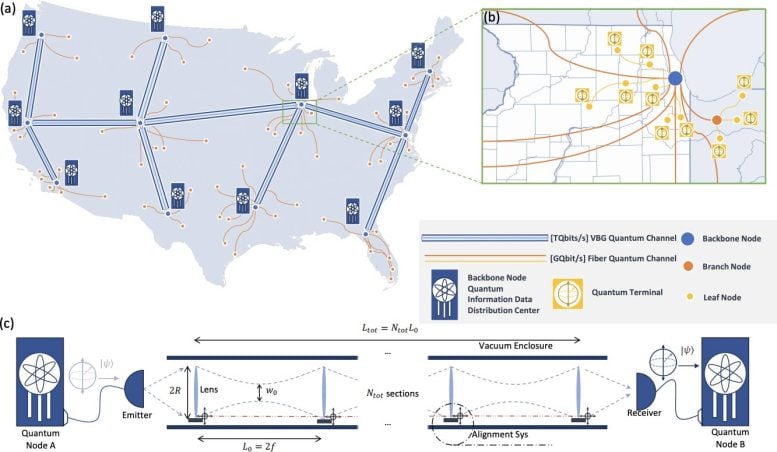
Researchers outlined a new method to build a quantum network that spans the country by using vacuum beam guides, in which qubits can travel thousands of miles inside small vacuum-sealed tubes. Credit: SciTechDaily.com
A new approach for quantum networks involves using vacuum sealed tubes with spaced-out lenses to transport quantum data via photons over long distances. This method, developed by scientists at the 
To make a quantum network a reality, researchers in Jiang Group at the University of Chicago Pritzker School of Molecular Engineering have proposed building long quantum channels using vacuum-sealed tubes with an array of spaced-out lenses. Credit: Jiang Group
Innovating Quantum Communication
Now, researchers at the University of Chicago Pritzker School of Molecular Engineering (PME) have proposed a new approach — building long quantum channels using vacuum sealed tubes with an array of spaced-out lenses. These vacuum beam guides, about 20 centimeters in diameter, would have ranges of thousands of kilometers and capacities of 10 trillion qubits per second, better than any existing quantum communication approach. Photons of light encoding quantum data would move through the vacuum tubes and remain focused thanks to the lenses.
“We believe this kind of network is feasible and has a lot of potential,” said Liang Jiang, professor of molecular engineering and senior author of the new work. “It could not only be used for secure communication, but also for building distributed 
University of Chicago Pritzker School of Molecular Engineering Prof. Liang Jiang reviews the proposed quantum network using vacuum beam guides, which would have ranges of thousands of kilometers and capacities of 10 trillion qubits per second, better than any existing quantum communication approach. Credit: UChicago Pritzker School of Molecular Engineering / John Zich
Quantum Properties and Data Transmission
While classical computers encode data in conventional bits — represented as a 0 or 1 — quantum computers rely on qubits, which can exhibit quantum phenomena. These phenomena include superposition — a kind of ambiguous combination of states — as well as entanglement, which allows two quantum particles to be correlated with each other even across vast distances.
These properties give quantum computers the ability to analyze new types of data and store and pass along information in new, secure ways. Connecting multiple quantum computers can them even more powerful, as their data processing abilities can be pooled. However, networks typically used to connect computers are not ideal because they cannot maintain the quantum properties of qubits.
“You can’t send a quantum state over a classical network,” explained Jiang. “You might send a piece of data classically, a quantum computer can process it, but the result is then sent back classically again.”
Some researchers have tested ways of using fiber-optic cables and satellites to transmit optical photons, which can act as qubits. Photons can travel a short distance through existing fiber-optic cables but generally lose their information quickly as photons are absorbed. Photons bounced to satellites and back to the ground in a new location are absorbed less because of the vacuum of space, but their transmission is limited by the atmosphere absorption and availability of the satellites.
“What we wanted to do was to combine the advantages of each of those previous approaches,” said PME graduate student Yuexun Huang, the first author of the new work. “In a vacuum, you can send a lot of information without attenuation. But being able to do that on the ground would be ideal.”
“We believe this kind of network is feasible and has a lot of potential.”
— Prof. Liang Jiang
Ground-Based Vacuum Tubes and Quantum Information
Scientists working at the Laser Interferometer Gravitational-Wave Observatory (LIGO) the California Institute of Technology (Caltech) have built huge ground-based vacuum tubes to contain moving photons of light that can detect SciTechDaily


